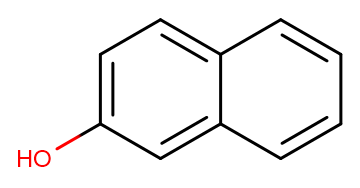
2-Naphthol
CAS No. 135-19-3
2-Naphthol( Betanaphthol | NSC 2044 | NSC-2044 | NSC2044 )
Catalog No. M11424 CAS No. 135-19-3
2-Naphthol, or β-naphthol, is a fluorescent colorless crystalline solid with the formula C10H7OH.
Purity : >98% (HPLC)
 COA
COA
 Datasheet
Datasheet
 HNMR
HNMR
 HPLC
HPLC
 MSDS
MSDS
 Handing Instructions
Handing Instructions
| Size | Price / USD | Stock | Quantity |
| 1G | 27 | In Stock |


|
Biological Information
-
Product Name2-Naphthol
-
NoteResearch use only, not for human use.
-
Brief Description2-Naphthol, or β-naphthol, is a fluorescent colorless crystalline solid with the formula C10H7OH.
-
Description2-Naphthol, or β-naphthol, is a fluorescent colorless crystalline solid with the formula C10H7OH. It is an isomer of 1-naphthol, differing by the location of the hydroxyl group on the naphthalene ring. The naphthols are naphthalene homologues of phenol, but more reactive. Both isomers are soluble in simple alcohols, ethers, and chloroform. 2-Naphthol is a widely used intermediate for the production of dyes and other compounds.(In Vitro):2-Naphthol is a metabolite of naphthalene, catalyzed by cytochrome P450 (CYP) isozymes (CYP 1A1, CYP 1A2, CYP 2A1, CYP 2E1 and CYP 2F2). 2-Naphthol (10, 25, 50 and 100 μM) causes no cytotoxic effect and the inhibition of peripheral-blood mononuclear cells proliferation.
-
In Vitro2-Naphthol is a metabolite of naphthalene, catalyzed by cytochrome P450 (CYP) isozymes (CYP 1A1, CYP 1A2, CYP 2A1, CYP 2E1 and CYP 2F2). 2-Naphthol (10, 25, 50 and 100 μM) causes no cytotoxic effect and the inhibition of peripheral-blood mononuclear cells proliferation.
-
In Vivo——
-
SynonymsBetanaphthol | NSC 2044 | NSC-2044 | NSC2044
-
PathwayOthers
-
TargetOther Targets
-
RecptorOthers
-
Research Area——
-
Indication——
Chemical Information
-
CAS Number135-19-3
-
Formula Weight144.17
-
Molecular FormulaC10H8O
-
Purity>98% (HPLC)
-
SolubilityDMSO: 10 mM
-
SMILESOC1=CC=C2C=CC=CC2=C1
-
Chemical Name2-Naphthalenol
Shipping & Storage Information
-
Storage(-20℃)
-
ShippingWith Ice Pack
-
Stability≥ 2 years
Reference
1.Ad?o P, et al. Dalton Trans. 2015 Jan 28; 44(4):1612-26.
molnova catalog



related products
-
Thalidomide-O-amido-...
Thalidomide-O-amido-PEG-C2-NH2 hydrochloride, a synthesized E3 ligase ligand-linker conjugate that incorporates the Thalidomide based cereblon ligand and a linker, can be used in the synthesis of PROTACs.
-
Melanostatin, frog
Melanostatin, frog
-
BD-AcAc 2
BD-AcAc 2 (Ketone Ester), added in diet, could elevate mean blood ketone bodies of 3.5 mm and lowered plasma glucose, insulin, and leptin in animals.



 Cart
Cart
 sales@molnova.com
sales@molnova.com


